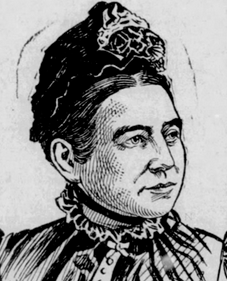Other inventors contemporary to Mary Beasley were Ada Byron, a British mathematician and writer, most famous for her work on the mechanical general-purpose computer who is considered the first programmer; Helen Augusta Blanchard (Lady Edison), an American inventor who registered 28 patents between 1873 and 1915, among other inventions related to sewing machines and sewing technology or Margaret Eloise Knight whose best known invention is the flat-bottomed paper bag, which is still in use today.

María Beasley
Philadelphia (United States), 1847 — United States, 1904
Period of activity: 1878 — 1896
Geographical classification: America > United States
Socio-cultural movements
Late modern period / Contemporary period
Groups by dedication
Technologists > Engineers
Technologists > Object designers
Technologists > Inventors
Professionals / Other groups > Businesswomen / Executives / Administrative managers
Plastic, visual and performing artists > Dressmakers / Fashion designers
Context of feminine creation
Review
American entrepreneur and inventor. She holds fifteen different patents in the USA and two in the UK. She is known for inventions like the barrel-making machine and two improved lifeboats models, used among others on the Titanic. She also created foot warmers, pans, anti-derailment devices for trains and other inventions.
Activities
Justifications
Biography
Beasley was born as Marie Kenny in 1847 in Philadelphia, Pennsylvania, USA, and little is known about her education. It is unclear how she got inspired to become inventor, although some speculate that she was influenced by the Centennial Exhibition (and specifically the Women's Pavilion) in 1876. She married Samuel Beasley in 1865, running the household in addition to her business and her creative activities. Philadelphia's Directories in 1880-1890 (with an interruption in 1887) cite her on their lists as seamstress, even though she presented several patents and developed a barrel-making business during that time. Afterwards, between 1891 and 1896, the Chicago Directories already mentioned her occupation as inventor. Beasley died in 1904.
Beasley's first patent was granted in 1878. Then she invented a barrel-hooping machine, which was exhibited at the 1884 World's Industrial and Cotton Exhibition.
Beasley's barrel stringing machine was designed to accelerate the barrel production, enabling the production of 1,500 barrels per day. Beasley's barrel hitching machine made her quite a bit of money, with the Evening Star magazine writing in 1889 that she "made a small fortune out of a barrel making machine".
Beasley's other inventions included foot warmers, pans, anti-derailment devices for trains and two improved lifeboat designs, which were also patented in Britain. Her lifeboats were used on the Titanic.
From 1878 on, Beasley received a series of eight patents for the barrel-making process. These included six mechanical patents, including two barrel making machines with single labels, two for hoop handling, one for barrel configuration and one for barrel stave forming.
She exhibited a barrel-making machine at the World's Industrial and Cotton Centennial Exposition in New Orleans in 1884. Her inventions attracted sugar and oil refineries and the royalties from contracts involving the use of its barrel hitching machine amounted to $20,000 per year. Some reports also suggest that she herself ran a barrel-manufacturing business, in addition to the contracts she had with sugar and oil companies.
After her success in the industry of barrel-manufacturing business, Beasley tried to create an improved lifeboat being "fire-proof, compact, safe and easy to launch". She created this new design in 1880.
Her new design included railings surrounding the raft and rectangular metal floats. This design is capable of folding and unfolding, that is why it is easy to store, even with the rails. Prior to Beasley's design, liferafts were typically flat wooden planks. Railing and small storage concepts are still in use today, although their exact designs are long outdated.
Beasley's lifeboat played a critical role in the sinking of the Titanic. The RMS Titanic was a British passengers ship which sailed the 15th of April 1912. During her first trip from the UK to New York, in the US, the liner struck an iceberg and sank into the Atlantic Ocean. From about 2000 people on board, more than 1000 went missing. However, the ship was carrying 20 of Beasley's lifeboats, allowing 706 men, women, and children to survive and stay safe until help arrived.
Source: https://es.wikipedia.org/wiki/Maria_Beasley (17/02/2022)
Works
She holds 15 patents in the US and 2 in the UK, the best-known of which are:
Lifeboat's patents.
Barrel hoop's machine patents.
Bibliography
Maria Beasly, in Wikipedia, (17/03/2022), <https://es.wikipedia.org/wiki/Maria_Beasley>
Didactic approach
It is possible to work with this author in technology, in the block of structures and mechanisms of 1st of ESO; and also in the block of technological problem solving of 1st and 2nd of ESO. It is also possible to study her in English, when working texts of their patents (Life raft patent, Barrel hooping machine patent.; https://www.google.com/patents/US448905).